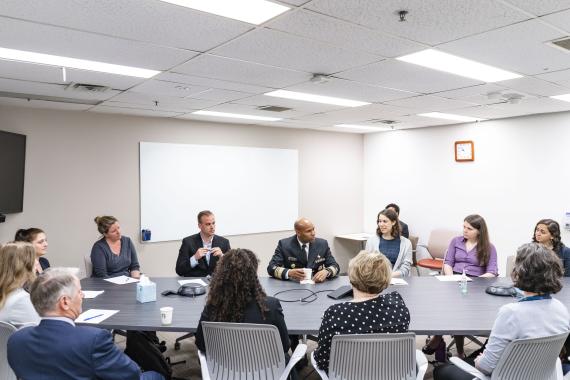In early June, first-year geography M.A. student Emma Gause was invited to meet with U.S. Surgeon General Dr. Jerome Adams, whose "Spotlight on Opioids" draws on research directly related to Gause's areas of developing expertise. Touring around the U.S. to draw attention to this topic, Dr. Adams visited the School of Public Health where Gause is concurrently completing an M.S. in Epidemiology while working as a Graduate Student Research Assistant at the Harborview Injury Prevention & Research Center. Here, Gause describes her background and the current research project that led to this high-profile meeting!
"My previous work experience at the Vermont Department of Health was very interdisciplinary, incorporating elements of geography and public health. I started as the GIS intern and was later hired as the EMS Data manager within the Division of Emergency Preparedness, responsible for overseeing the EMS data program for the State of Vermont. With EMS and Emergency Preparedness, location information is particularly important, whether its mapping out injury burden in the state to target interventions, measuring response times by distance for 911 incidents, or identifying the ideal points of distribution (POD sites) that can reach the largest number of people in the event of an emergency.
Working with Professor Jonathan Mayer at UW was one of the few (and certainly the best) graduate opportunities I identified that seamlessly combined my two professional interests of geography and public health. Originally I enrolled in the School of Public Health epidemiology courses to fulfill my methods requirements for my geography [M.A.], but I quickly realized that to acquire the advanced methodological skills I wanted to possess, I would need to complete two degrees. I applied for the M.S. Epidemiology program and happily was accepted into the program for Autumn 2019. I will complete both degrees concurrently (hopefully in just two years). Already this interdisciplinary approach has made me a better student and researcher in both arenas. I am able to use this combination of skill sets in my current research assistant position at the Harborview Injury Prevention & Research Center.
It was my interest and experience in GIS that lead me to be invited to join the opioid and firearm project with Dr. Ali Rowhani-Rahbar and Ph.D. student Erin Morgan.
I am the lead author on the geospatial investigation of firearm suicide and opioid deaths in the United States - this will be one of my geography thesis projects. This is a complement to the work that Erin and Dr. Rowhani-Rahbar are already doing with firearm research at the School of Public Health and the newly created Firearm Injury & Policy Research Program at Harborview Injury Prevention & Research Center. Together with Erin, I am interested in investigating how deaths of despair - specifically, opioid overdose and firearm suicide - vary across the United States. We describe our project as including ' geographic and temporal patterns of each of these two emerging public health crises over the past twenty years, as well as their co-variation. We hope that by describing these problems we may gain insight on how they each contribute to the incidence of the other. These analyses also potentially help in the generation of hypotheses regarding policies related to prevention of both outcomes.' I had the opportunity to share this work with the Surgeon General at the June 14th meeting. We discussed how zip code is a major social determinant of health, and the importance of location for identifying vulnerable populations and targeting interventions."
